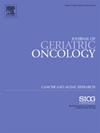Daily life mobility detects frailty, falls, and functioning in older prostate cancer survivors treated with androgen deprivation therapy
IF 3
3区 医学
Q3 GERIATRICS & GERONTOLOGY
引用次数: 0
Abstract
Introduction
Androgen deprivation therapy (ADT) increases the risk of frailty, falls, and poor physical functioning in older adults with prostate cancer. Detection of frailty is limited to self-report instruments and performance measures, so unbiased tools are needed. We investigated relationships between an unbiased measure – daily life mobility – and ADT history, frailty, fall history, and functioning in older prostate cancer survivors treated with ADT.
Materials and Methods
This cross-sectional study recruited prostate cancer survivors with a history of ADT from an exercise clinical trial, an academic medical center, and the community. Participants completed performance measures and surveys to assess frailty, fall history, and physical functioning, then wore instrumented socks for up to seven days to continuously monitor daily life mobility. We performed a principal component analysis on daily life mobility metrics and used regression analyses to investigate relationships between domains of daily life mobility and frailty, fall history, and physical functioning.
Results
Participants (N = 99) were aged 73.0 +/− 7.3 years, most were pre-frail or frail (75 %), and 35 % had fallen at least once in the last year. Daily life mobility metrics clustered into four domains: Gait Pace, Rhythm, Activity, and Balance. Worse scores on Rhythm and Activity were associated with increased odds of frailty (odds ratio [OR] 1.59, 95 % confidence interval [CI]: 1.04, 2.49 and OR 1.81, 95 % CI: 1.19, 2.83, respectively). A worse score on Rhythm was associated with increased odds of ≥1 falls in the previous year (OR 1.60, 95 % CI: 1.05, 2.47). Worse scores on Gait Pace, Rhythm, and Activity were associated with worse physical functioning. Mobility metrics were similar between current and past users of ADT.
Discussion
Continuous passive monitoring of daily life mobility may identify prostate cancer survivors who have developed frailty, falls, and declines in physical functioning.
在接受雄激素剥夺治疗的老年前列腺癌幸存者中,日常生活活动能力可以检测出虚弱、跌倒和功能。
导言:雄激素剥夺疗法(ADT)增加了老年前列腺癌患者虚弱、跌倒和身体功能差的风险。弱点的检测仅限于自我报告工具和绩效测量,因此需要无偏见的工具。我们调查了接受ADT治疗的老年前列腺癌幸存者的ADT病史、虚弱、跌倒史和功能之间的无偏测量-日常生活活动能力-的关系。材料和方法:本横断面研究招募了来自运动临床试验、学术医疗中心和社区的有ADT病史的前列腺癌幸存者。参与者完成了表现测量和调查,以评估虚弱,跌倒史和身体功能,然后穿着带仪器的袜子长达七天,以连续监测日常生活活动能力。我们对日常生活活动指标进行了主成分分析,并使用回归分析来调查日常生活活动领域与虚弱、跌倒史和身体功能之间的关系。结果:参与者(N = 99)年龄为73.0 +/- 7.3岁,大多数为体弱或体弱(75%),35%在过去一年中至少跌倒过一次。日常生活活动指标分为四个领域:步态速度、节奏、活动和平衡。节律和活动评分较差与虚弱的几率增加相关(比值比[OR] 1.59, 95%可信区间[CI]: 1.04, 2.49, OR为1.81,95% CI: 1.19, 2.83)。较差的心律评分与前一年≥1次跌倒的几率增加相关(OR 1.60, 95% CI: 1.05, 2.47)。步态速度、节奏和活动度得分越低,身体功能越差。当前和过去ADT用户的移动性指标相似。讨论:对日常生活活动能力进行持续的被动监测,可以识别出患有虚弱、跌倒和身体功能下降的前列腺癌幸存者。
本文章由计算机程序翻译,如有差异,请以英文原文为准。
求助全文
约1分钟内获得全文
求助全文
来源期刊

Journal of geriatric oncology
ONCOLOGY-GERIATRICS & GERONTOLOGY
CiteScore
5.30
自引率
10.00%
发文量
379
审稿时长
80 days
期刊介绍:
The Journal of Geriatric Oncology is an international, multidisciplinary journal which is focused on advancing research in the treatment and survivorship issues of older adults with cancer, as well as literature relevant to education and policy development in geriatric oncology.
The journal welcomes the submission of manuscripts in the following categories:
• Original research articles
• Review articles
• Clinical trials
• Education and training articles
• Short communications
• Perspectives
• Meeting reports
• Letters to the Editor.
 求助内容:
求助内容: 应助结果提醒方式:
应助结果提醒方式:


